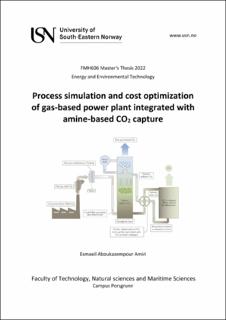| dc.description.abstract | Integration of gas-based power plants with CO2 capture technologies is an efficient and cost-effective technique to remove carbon dioxide from their flue gas emissions and reduce greenhouse gas emissions to reduce global warming and climate change. Also, the removal of CO2 by utilizing an amine-based solvent from the exhaust gas is an effective and well-proven process.
The base case scenario was modeled in the Aspen HYSYS by using the input data parameters from earlier works on a natural gas-fired power plant. In the design of the base case simulation in order to cost evaluate the turbine inlet temperatures, the power generation of the combined cycle, the CO2 removal efficiency, the minimum temperature approach in the lean-rich heat exchanger and the flue gas inlet to absorber temperature were all set at 1500 °C, 400 MW, 85%, 10 °C, and 40 °C, respectively. And Aspen In- Plant Cost Estimator tool, Enhanced Detailed Factor (EDF) technique, and net present value (NPV) method were used to estimate the overall cost of the base case model. The CAPEX, OPEX, and revenue from selling power were considered in the cost evaluation. The cost calculation outcome indicates a net present value of €1570 million over a 25- year plant lifetime and a payback period of 7 years after project implementation.
Sensitivity analysis was applied to perform cost optimization. The Power-Law method was used to estimate the new cost when the size of equipment is altered. In sensitivity analysis, ambient temperature, inlet air/gas pressure into the power plant, flue gas outlet temperature from the power plant (off-gas), the lean-rich heat exchanger's minimum temperature approach, number of stages in the absorption column, inlet flue gas temperature to the absorber column were all changed to reach the project's highest net present value.
The cost-optimized process parameters, according to the results of the sensitivity analysis, will be achieved at lower ambient temperatures (in this case, 10 °C), inlet air/gas pressure of 25 bar, off-gas temperature of 50 °C, minimum temperature approaching 13 °C in leanrich heat exchangers, 10 stages of absorber columns, and inlet flue gas temperatures in the range of 30 to 35.
The results of the cost optimization process parameter analysis obtained from the sensitivity study were used to modify the base case. The calculated NPV results provide an average 15 % increase in profit compared to the initial base case. In this study, the main objective is to use the Aspen HYSYS package to estimate and optimize the cost of a gas-based power plant integrated with an MEA-based CO2 capture plant. A cost optimization calculation of the model's process parameters, which include a CO2 removal plant and a gas-based power plant simultaneously has not been found in earlier work and in this aspect, this work is innovative. | |
